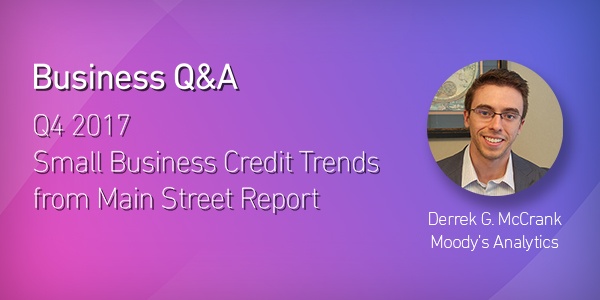
Gary Stockton: Experian has just released the Q4 2017 Main Street Report. We partner with Moody’s Analytics on this report each quarter, and Derrek Grunfelder-McCrank is the economist who works on the report. We asked him a few questions about the trends that we’re seeing in this quarter’s data.
Gary Stockton: The latest Main Street Report states that small business credit conditions remain positive. Is there a primary factor that’s driving this stability?
Derrek G. McCrank: Yeah there certainly is Gary. The primary factor that’s driving stability in small business credit is the broader U.S. economy. Right now we have the labor market that’s tight. This is resulting in wage increases for consumers as a result.
Consumer spending has been reliable. Inflation is starting to pick up in a slow steady manner. On top of it all at the end of last year we just got tax reform. Right now the outlook for small business credit is positive. And that doesn’t look set to change anytime soon.
Gary Stockton: and are you seeing greater numbers of small businesses investing in that business by borrowing for equipment purchases?
Derrek G. McCrank: Well Gary while we can’t say for certain. The data seems to suggest that this isn’t happening to the extent it could just yet. One of the questions in the NFIB’s monthly survey is about whether firms are planning capital expenditures in the next three to six months. Since the end of the last recession.
We’ve seen the positive response rate to this question steadily increasing. However it still sits below its long term average. Couple this with tax reform coming so late at the end of last year, and a decent number of firms are likely to have waited until the new year when they could invest in their business with a little more certainty.
Gary Stockton: Well historically small businesses been keeping bankruptcy in check, but this quarter we saw it up slightly. Is this a major concern?
Derrek G. McCrank: This isn’t a cause for concern yet. Though it is something to monitor going forward. In the first quarter of 2017 the small business bankruptcy rate bottomed out, it hi its floor. As the year progressed, the bankruptcy rate moved off of that floor and that appears to be all that happened.
In fact I’m hopeful that this might indicate a return to a more dynamic environment for small businesses which I look forward to discussing in a little more detail and our upcoming webinar. But for now, given the state of the economy, I’m optimistic for the state of small business credit.
Gary Stockton: On the flip side, the Northeast saw a steep decline in business bankruptcies in Q4. Can you share some insight on what might be driving that?
Derrek G. McCrank: Sure, so in the fourth quarter. the Northeast saw declines in its severely delinquent or 90 days past due rate coupled with a slight uptick in its business bankruptcy rate.
What happened with business bankruptcies mirrored the trend nationally, so it shouldn’t be a cause for concern this year, the declines in the severely delinquent rate were driven by two primary factors – geography and industry, from a geographic point of view, Connecticut, New Hampshire and Maine were the driving forces behind the reductions in severe delinquency, and from an industrial point of view financial services, public administration and the manufacturing industries are credited with declines in severe delinquency.

